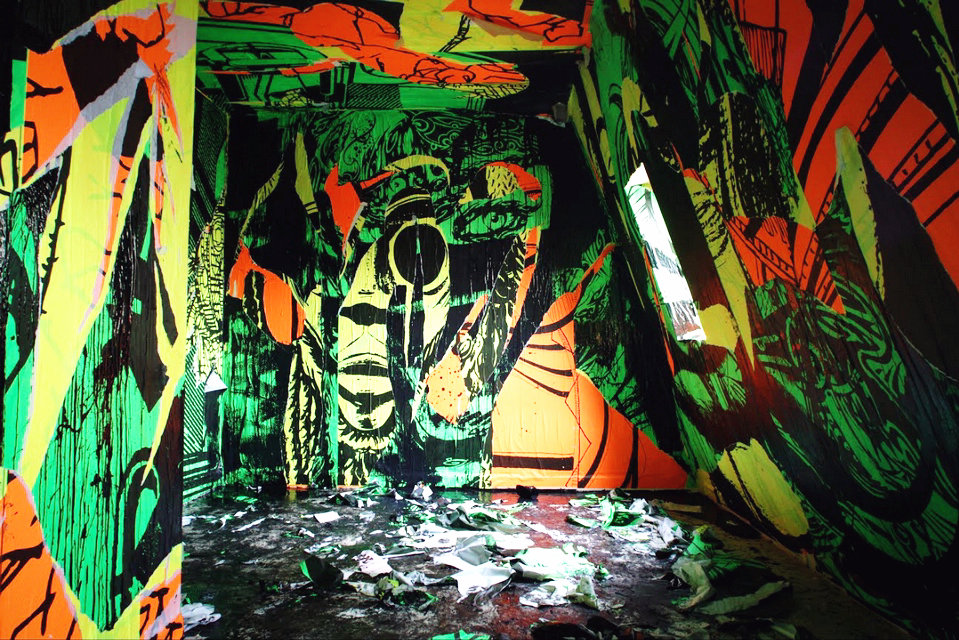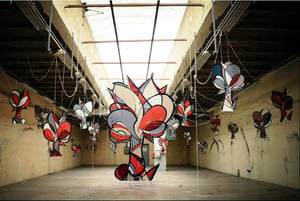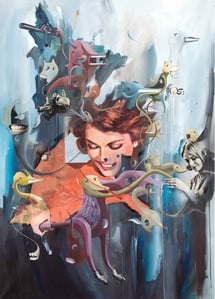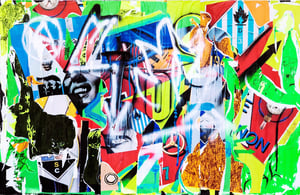The “Scratch Papers” concept pays a sort of homage to the New Realists through a reactivation of the “Anonymous lacerater.” For, at the outset, when he undertook his approach, Villeglé, persuaded that that approach was within anyone’s grasp and that it should, consequently, become a widespread practice, hardly was affirming its “artistic” dimension. To Stéphane Carricondo of Ninth Concept, he made it clear, during a charity sale organized by Marlène Nathan de Lara, that his approach was indeed Dadaist:
With tearing—the antidote to all propaganda—advertising, a compendium of civilization, was introduced into the domain of what is fortunately illegible! It is because he is not resigned to the real that the lacerater, who senses the constraints acting upon him, acts via protest, and in particular by protesting against the rape of crowds by the action of propaganda. He thus introduces the childhood domain of the possible into the adult world of the real.Through such events, the collective attains a certain degree of abstraction even as it achieves a hyperrealistic rendering of the urban world that is made up as much of geological strata as layers of fluorescent paper.
In january 2013, The 9th Concept was invited to produce a Scratch Paper performance in the mythical Night life Club “Les bains Douches” by Magda Danysz art gallery.
It was a fabulous opportunity to celebrate french street art before the destruction of this incredible music place.
They cover a site or a canvas with their paper collages, which in the end are concealed beneath a broad flat layer of paint. The idea is for each of the collective’s artists, along with guests from the world over, to offer drawings, writings, signs, logos, photographs, and so on. The members of the collective have handed out “scratch papers” notebooks as a medium for free expression. The main principle at work here is to foreground black-and-white drawing as a way of illustrating lines from every angle: straight, curved, continuous or discontinuous, even or uneven. Next, the artists transpose all the different offerings onto large, industrial-sized florescent-colored sheets of paper. These original pages are then glued one onto another, so as to produce one thick layer that will be washed over its entire surface with black paint or covered up with yellow, green, or orange paper. In the course of spectacular operations, the members of the collective invite participants to rip into the colored layers so that one might see fragments of works being pieced back together as one tears into the monochromatic surface which disappears before one’s very eyes. Whether the work would be produced with the help of several known or unknown contributors or by an accumulation of drawings from a single artist, the goal remains the same: foregrounding a universal line that stretches all the way around the world, from Paris to Rio and from New York to Bombay! Reflection of one’s individual personality suddenly gives way so that inspiration might ricochet forevermore off of mirrors made of paper. As with Surrealist cadavres exquis, the result obtained exceeds the capacities of each and reveals a dialectical fecundity among points of agreement and dissimilarity. Moreover, the proliferation of contributors sketches out a utopian creativity that would be present in each individual even as it tends to vindicate their anonymity once it starts to become difficult to distinguish what properly belongs to each.
In cropping the work and in amassing their own pieces so that they might slash them up, hollow them out, and tear into them, what the artists discover beneath are random compositions, broken letters, while the luck of the rip reveals expanses of color whose juxtapositions may alternatively prove disconcerting or marvelous: figures overlap, complement one another, or, on the contrary, split up, divide, break into fragments, and clash. The mixing up of various drawings, styles, and handwritten traces testifies to the great diversity of sources.
The group makes no effort to conceal its admiration for the work of Jacques Villeglé and the Affichistes from the 1960s. Yet it must be recalled that in their time what Villeglé, Raymond Hains, and Mimmo Rotella were sampling on walls and panels were advertising posters, political posters, and movie posters that had already been lacerated by passers-by, whereas the collective’s members have recourse to printed productions of their own making. Chance is therefore somewhat under control here.
“Disco” colors, which usually serve as signage, are used to dapple the space or the canvas with streaks while allowing one to accentuate the contrasts, thus giving these pictures their enchanting allure. Joy, exultation, jubilation, and even intoxication seem to be in play here as the final product is worked out. Touches of pink, yellow, green, and orange radiating from drawings that touch one another, stand side by side, and join together are strangely evocative of the glowing of stars as well as of the world of industry
With “Scratch Papers,” the Ninth Concept achieves a collective signage made of science-fiction characters and bizarre robots, as well as Indians and Aborigines, comical monsters baring their teeth, and pretty girls, their hair blowing in the wind like large casual sweeps of brush strokes. This mix of various trends in the graphic arts allows one to discover styles and complex universes that combine figurative representation with abstraction.
The intention behind this new collective approach is to create “a new urban skin” and to extend it outward. While chance and accidental happenstance seem to rule here, what the artists really are proposing are speleological incursions into the very core of the city. They give birth to a technique of creative actions that themselves allow interactions, fusions, and surprises. Tear after tear, snippet after snippet, reject after reject, these works take on their full dimensions in their blendings of acts of gestural violence that are matched only by the meticulousness of the drawings. What surges forth from these uncontrolled acts of ripping and the preciosity of the “Scratch Papers” drawings, characters, strokes, markings, hatchings, lines, and contours is the idea of fragmenting the world so that one might afterward reassemble it into a fascinating chaos.













